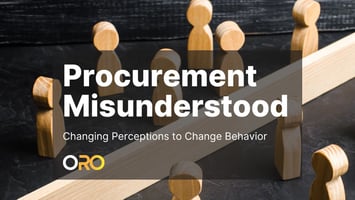Navigating the Complexities of ESG Sourcing in Procurement In today's business landscape,...
Taking Sourcing to the Next Level with Procurement Orchestration
In a recent SIG webinar, Lalitha Rajagopalan, Co-founder and Head of Product Strategy & Marketing at ORO Labs joined SIG CEO Dawn Tiura to share insightful perspectives on transforming procurement through orchestration. The discussion shed light on the evolving landscape of procurement, emphasizing the critical role of user experience, the importance of category strategy, the need to empower self-service and collaboration, and how to support compliance through visibility and agility in response to change.
Enhancing User Experience
Modern procurement isn't just about completing tasks but delivering exceptional user experiences. A procurement orchestration layer plays a pivotal role in streamlining operations, automating manual checks, and seamlessly integrating various tools to unify procurement processes. By focusing on user needs and providing guided processes, organizations can ensure smoother operations and unlock the true value of digital transformation initiatives.
The Importance of Category Strategy
Challenges often arise right from the outset when it comes to category strategy in procurement. A robust category strategy is crucial for effective procurement management. For example, Lalitha provides an example of a company struggling with managing professional services spending across multiple channels and tools. Here, orchestration ensures that business partners are directed to the right buying channel and are guided through the buying process as part of a smooth procurement experience.
Empowering Self-Service
Procurement organizations often face challenges in scaling operations to meet user needs efficiently. By leveraging procurement orchestration, organizations can empower business users, streamline processes, and enable faster decision-making. Self-service procurement isn't just about simplifying intake; it's about optimizing the entire procurement journey for enhanced agility and effectiveness.
Navigating Buying Channels
Buying channels have emerged as a key focus area with a need for a comprehensive buying channel strategy. Procurement orchestration goes beyond just selecting suppliers; it defines how procurement is executed, taking into account factors like compliance, risk assessment, and execution modalities. By automating buying channel strategies, organizations can ensure consistency, reduce manual effort, and enhance operational efficiency across diverse procurement scenarios.
Audit-Ready Procurement
One of the most compelling aspects of procurement orchestration is its ability to ensure compliance and audit readiness. A procurement orchestration layer serves as an audit-ready tool, providing granular reporting and tracking capabilities. From clarifying requirements to monitoring response times, orchestration ensures transparency, accountability, and adherence to procurement protocols, significantly reducing the burden of manual documentation and audits.
In this webinar, Lalitha underscored the transformative potential of procurement orchestration in driving organizational agility, efficiency, and value creation. By prioritizing user experience, optimizing category strategies, enabling self-service procurement, and navigating buying channels effectively, organizations can unlock new opportunities for growth and innovation in the procurement landscape.






